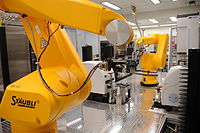
Photo from wikipedia
BackgroundTransgenic zebrafish lines with the expression of a fluorescent reporter under the control of a cell-type specific promoter, enable transcriptome analysis of FACS sorted cell populations. RNA quality and yield… Click to show full abstract
BackgroundTransgenic zebrafish lines with the expression of a fluorescent reporter under the control of a cell-type specific promoter, enable transcriptome analysis of FACS sorted cell populations. RNA quality and yield are key determinant factors for accurate expression profiling. Limited cell number and FACS induced cellular stress make RNA isolation of sorted zebrafish cells a delicate process. We aimed to optimize a workflow to extract sufficient amounts of high-quality RNA from a limited number of FACS sorted cells from Tg(fli1a:GFP) zebrafish embryos, which can be used for accurate gene expression analysis.ResultsWe evaluated two suitable RNA isolation kits (the RNAqueous micro and the RNeasy plus micro kit) and determined that sorting cells directly into lysis buffer is a critical step for success. For low cell numbers, this ensures direct cell lysis, protects RNA from degradation and results in a higher RNA quality and yield. We showed that this works well up to 0.5× dilution of the lysis buffer with sorted cells. In our sort settings, this corresponded to 30,000 and 75,000 cells for the RNAqueous micro kit and RNeasy plus micro kit respectively. Sorting more cells dilutes the lysis buffer too much and requires the use of a collection buffer. We also demonstrated that an additional genomic DNA removal step after RNA isolation is required to completely clear the RNA from any contaminating genomic DNA. For cDNA synthesis and library preparation, we combined SmartSeq v4 full length cDNA library amplification, Nextera XT tagmentation and sample barcoding. Using this workflow, we were able to generate highly reproducible RNA sequencing results.ConclusionsThe presented optimized workflow enables to generate high quality RNA and allows accurate transcriptome profiling of small populations of sorted zebrafish cells.
Journal Title: BMC Genomics
Year Published: 2019
Link to full text (if available)
Share on Social Media: Sign Up to like & get
recommendations!